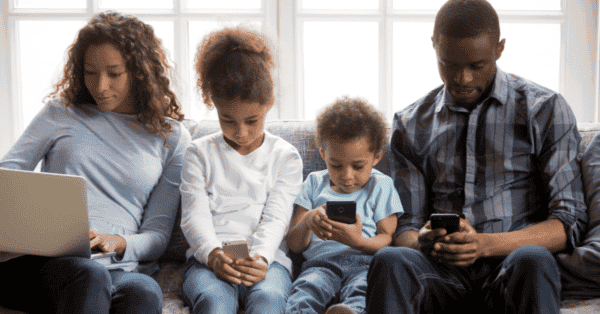How can I spot when my child has had ‘too much’ screen time?
अमेरिकन एकेडमी ऑफ पीडियाट्रिक्स के मूल रुख (1999) से दो वर्ष से कम उम्र के बच्चों के लिए कोई स्क्रीन समय नहीं बताया गया है, बाद में सीमित करने की अनुमति में एक अधिक बारीक दृष्टिकोण (2016) के लिए अद्यतन किया गया। बच्चों के लिए उच्च गुणवत्ता की सामग्री, हम अब जानते हैं कि सभी स्क्रीन समय समान नहीं है।
The Royal College of Pediatrics and Child Health suggest that parents approach screen time “based on the child’s developmental age, the individual need and value the family place on positive activities such as socialising, exercise and sleep.”
परिवारों के लिए यह अच्छी तरह से सलाह स्क्रीन आधारित गतिविधियों के बारे में चिंताओं (और अपराधबोध) को कम करती है, प्रौद्योगिकी के सकारात्मक प्रभाव को प्रदर्शित करती है और माता-पिता को समय सीमा के बजाय स्क्रीन समय के संदर्भ और सामग्री पर ध्यान केंद्रित करने की अनुमति देती है।
But some parents and carers may still want to know: “when has my child had ‘too much’ screen time?”
As families and children differ, so does the effects of screen time. However, all parents can use these tips as a guideline.
यह देखें कि आपका बच्चा उनकी डिवाइस के साथ कैसे इंटरैक्ट करता है
- क्या उपकरण निकालने या स्क्रीन बंद होने पर मेरे बच्चे को टैंट्रम होता है?
- क्या मेरे बच्चे को गर्दन में दर्द या कमर दर्द की शिकायत है?
- क्या मेरे बच्चे को सिरदर्द या आंखों में खिंचाव की शिकायत है?
- क्या ऑनलाइन खेलते या देखते समय मेरा बच्चा आक्रामक या क्रोधित हो जाता है?
- क्या मेरा बच्चा अक्सर अति-उत्साहित लगता है?
- क्या मेरा बच्चा अव्यवस्थित, अवज्ञाकारी या विरोधी बन गया है?
यदि इन सवालों के बहुमत का जवाब 'हाँ' है, तो माता-पिता को स्क्रीन टाइम गतिविधियों को किसी और चीज़ के साथ पूरक करने पर विचार करना चाहिए।
Recognise when screen time negatively impacts children’s development
- क्या मेरा बच्चा परिवार और दोस्तों के साथ सामाजिक रूप से जुड़ रहा है?
- क्या मेरा बच्चा शारीरिक रूप से स्वस्थ है और पर्याप्त नींद ले रहा है?
- क्या मेरा बच्चा स्कूल में काम कर रहा है और उसे हासिल कर रहा है?
- क्या मेरा बच्चा हितों और शौक (किसी भी रूप में) का पीछा कर रहा है?
- क्या मेरा बच्चा मज़ेदार है और डिजिटल मीडिया के उपयोग में सीख रहा है?
If the answer to the majority of these questions is ‘No’, then parents may need to place limits on screen-based activities.
See more ways to manage screen time and tackle ‘too much’ of it.


